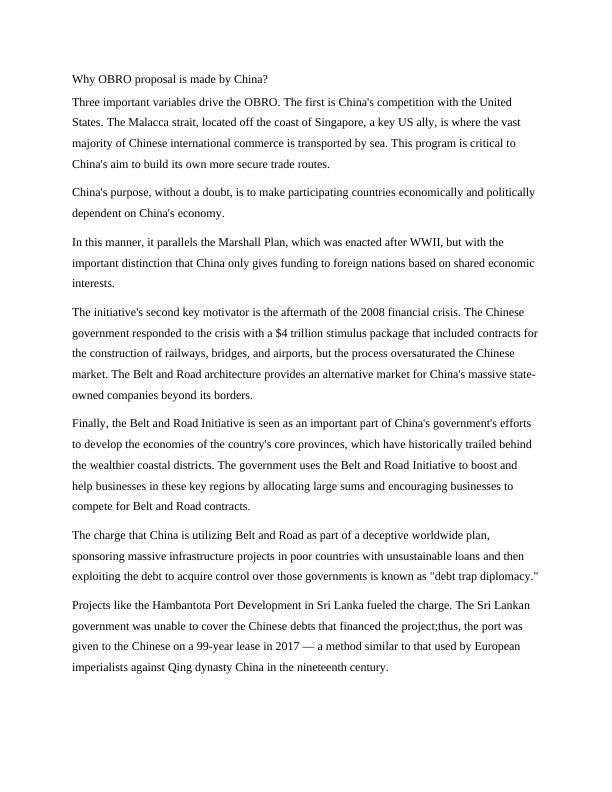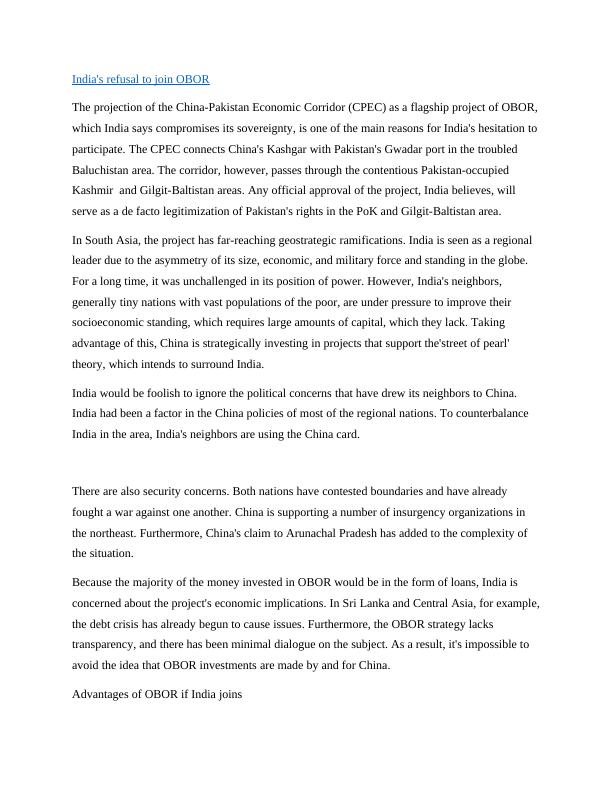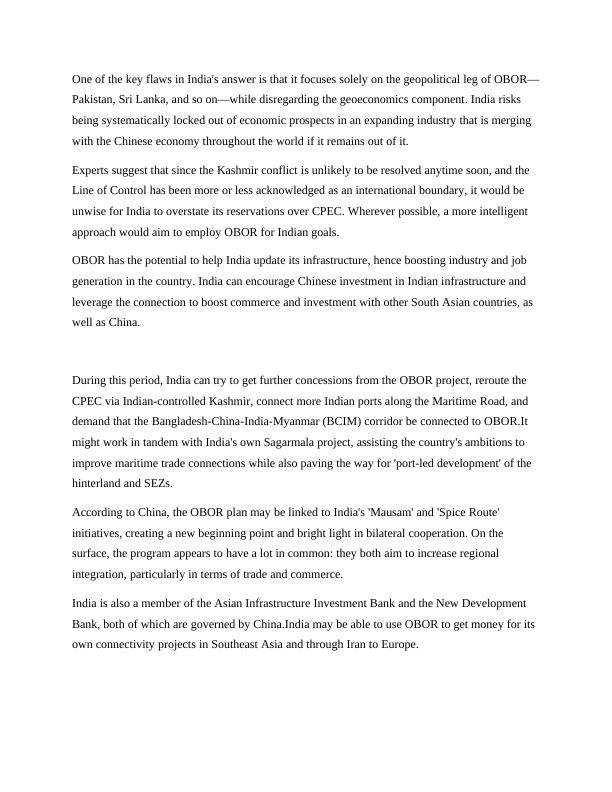Why OBRO proposal is made by China?.
8 Pages1929 Words3 Views
Added on 2022-11-17
Why OBRO proposal is made by China?.
Added on 2022-11-17
ShareRelated Documents
Why OBRO proposal is made by China?
Three important variables drive the OBRO. The first is China's competition with the United
States. The Malacca strait, located off the coast of Singapore, a key US ally, is where the vast
majority of Chinese international commerce is transported by sea. This program is critical to
China's aim to build its own more secure trade routes.
China's purpose, without a doubt, is to make participating countries economically and politically
dependent on China's economy.
In this manner, it parallels the Marshall Plan, which was enacted after WWII, but with the
important distinction that China only gives funding to foreign nations based on shared economic
interests.
The initiative's second key motivator is the aftermath of the 2008 financial crisis. The Chinese
government responded to the crisis with a $4 trillion stimulus package that included contracts for
the construction of railways, bridges, and airports, but the process oversaturated the Chinese
market. The Belt and Road architecture provides an alternative market for China's massive state-
owned companies beyond its borders.
Finally, the Belt and Road Initiative is seen as an important part of China's government's efforts
to develop the economies of the country's core provinces, which have historically trailed behind
the wealthier coastal districts. The government uses the Belt and Road Initiative to boost and
help businesses in these key regions by allocating large sums and encouraging businesses to
compete for Belt and Road contracts.
The charge that China is utilizing Belt and Road as part of a deceptive worldwide plan,
sponsoring massive infrastructure projects in poor countries with unsustainable loans and then
exploiting the debt to acquire control over those governments is known as "debt trap diplomacy."
Projects like the Hambantota Port Development in Sri Lanka fueled the charge. The Sri Lankan
government was unable to cover the Chinese debts that financed the project;thus, the port was
given to the Chinese on a 99-year lease in 2017 — a method similar to that used by European
imperialists against Qing dynasty China in the nineteenth century.
Three important variables drive the OBRO. The first is China's competition with the United
States. The Malacca strait, located off the coast of Singapore, a key US ally, is where the vast
majority of Chinese international commerce is transported by sea. This program is critical to
China's aim to build its own more secure trade routes.
China's purpose, without a doubt, is to make participating countries economically and politically
dependent on China's economy.
In this manner, it parallels the Marshall Plan, which was enacted after WWII, but with the
important distinction that China only gives funding to foreign nations based on shared economic
interests.
The initiative's second key motivator is the aftermath of the 2008 financial crisis. The Chinese
government responded to the crisis with a $4 trillion stimulus package that included contracts for
the construction of railways, bridges, and airports, but the process oversaturated the Chinese
market. The Belt and Road architecture provides an alternative market for China's massive state-
owned companies beyond its borders.
Finally, the Belt and Road Initiative is seen as an important part of China's government's efforts
to develop the economies of the country's core provinces, which have historically trailed behind
the wealthier coastal districts. The government uses the Belt and Road Initiative to boost and
help businesses in these key regions by allocating large sums and encouraging businesses to
compete for Belt and Road contracts.
The charge that China is utilizing Belt and Road as part of a deceptive worldwide plan,
sponsoring massive infrastructure projects in poor countries with unsustainable loans and then
exploiting the debt to acquire control over those governments is known as "debt trap diplomacy."
Projects like the Hambantota Port Development in Sri Lanka fueled the charge. The Sri Lankan
government was unable to cover the Chinese debts that financed the project;thus, the port was
given to the Chinese on a 99-year lease in 2017 — a method similar to that used by European
imperialists against Qing dynasty China in the nineteenth century.

India's refusal to join OBOR
The projection of the China-Pakistan Economic Corridor (CPEC) as a flagship project of OBOR,
which India says compromises its sovereignty, is one of the main reasons for India's hesitation to
participate. The CPEC connects China's Kashgar with Pakistan's Gwadar port in the troubled
Baluchistan area. The corridor, however, passes through the contentious Pakistan-occupied
Kashmir and Gilgit-Baltistan areas. Any official approval of the project, India believes, will
serve as a de facto legitimization of Pakistan's rights in the PoK and Gilgit-Baltistan area.
In South Asia, the project has far-reaching geostrategic ramifications. India is seen as a regional
leader due to the asymmetry of its size, economic, and military force and standing in the globe.
For a long time, it was unchallenged in its position of power. However, India's neighbors,
generally tiny nations with vast populations of the poor, are under pressure to improve their
socioeconomic standing, which requires large amounts of capital, which they lack. Taking
advantage of this, China is strategically investing in projects that support the'street of pearl'
theory, which intends to surround India.
India would be foolish to ignore the political concerns that have drew its neighbors to China.
India had been a factor in the China policies of most of the regional nations. To counterbalance
India in the area, India's neighbors are using the China card.
There are also security concerns. Both nations have contested boundaries and have already
fought a war against one another. China is supporting a number of insurgency organizations in
the northeast. Furthermore, China's claim to Arunachal Pradesh has added to the complexity of
the situation.
Because the majority of the money invested in OBOR would be in the form of loans, India is
concerned about the project's economic implications. In Sri Lanka and Central Asia, for example,
the debt crisis has already begun to cause issues. Furthermore, the OBOR strategy lacks
transparency, and there has been minimal dialogue on the subject. As a result, it's impossible to
avoid the idea that OBOR investments are made by and for China.
Advantages of OBOR if India joins
The projection of the China-Pakistan Economic Corridor (CPEC) as a flagship project of OBOR,
which India says compromises its sovereignty, is one of the main reasons for India's hesitation to
participate. The CPEC connects China's Kashgar with Pakistan's Gwadar port in the troubled
Baluchistan area. The corridor, however, passes through the contentious Pakistan-occupied
Kashmir and Gilgit-Baltistan areas. Any official approval of the project, India believes, will
serve as a de facto legitimization of Pakistan's rights in the PoK and Gilgit-Baltistan area.
In South Asia, the project has far-reaching geostrategic ramifications. India is seen as a regional
leader due to the asymmetry of its size, economic, and military force and standing in the globe.
For a long time, it was unchallenged in its position of power. However, India's neighbors,
generally tiny nations with vast populations of the poor, are under pressure to improve their
socioeconomic standing, which requires large amounts of capital, which they lack. Taking
advantage of this, China is strategically investing in projects that support the'street of pearl'
theory, which intends to surround India.
India would be foolish to ignore the political concerns that have drew its neighbors to China.
India had been a factor in the China policies of most of the regional nations. To counterbalance
India in the area, India's neighbors are using the China card.
There are also security concerns. Both nations have contested boundaries and have already
fought a war against one another. China is supporting a number of insurgency organizations in
the northeast. Furthermore, China's claim to Arunachal Pradesh has added to the complexity of
the situation.
Because the majority of the money invested in OBOR would be in the form of loans, India is
concerned about the project's economic implications. In Sri Lanka and Central Asia, for example,
the debt crisis has already begun to cause issues. Furthermore, the OBOR strategy lacks
transparency, and there has been minimal dialogue on the subject. As a result, it's impossible to
avoid the idea that OBOR investments are made by and for China.
Advantages of OBOR if India joins

One of the key flaws in India's answer is that it focuses solely on the geopolitical leg of OBOR—
Pakistan, Sri Lanka, and so on—while disregarding the geoeconomics component. India risks
being systematically locked out of economic prospects in an expanding industry that is merging
with the Chinese economy throughout the world if it remains out of it.
Experts suggest that since the Kashmir conflict is unlikely to be resolved anytime soon, and the
Line of Control has been more or less acknowledged as an international boundary, it would be
unwise for India to overstate its reservations over CPEC. Wherever possible, a more intelligent
approach would aim to employ OBOR for Indian goals.
OBOR has the potential to help India update its infrastructure, hence boosting industry and job
generation in the country. India can encourage Chinese investment in Indian infrastructure and
leverage the connection to boost commerce and investment with other South Asian countries, as
well as China.
During this period, India can try to get further concessions from the OBOR project, reroute the
CPEC via Indian-controlled Kashmir, connect more Indian ports along the Maritime Road, and
demand that the Bangladesh-China-India-Myanmar (BCIM) corridor be connected to OBOR.It
might work in tandem with India's own Sagarmala project, assisting the country's ambitions to
improve maritime trade connections while also paving the way for 'port-led development' of the
hinterland and SEZs.
According to China, the OBOR plan may be linked to India's 'Mausam' and 'Spice Route'
initiatives, creating a new beginning point and bright light in bilateral cooperation. On the
surface, the program appears to have a lot in common: they both aim to increase regional
integration, particularly in terms of trade and commerce.
India is also a member of the Asian Infrastructure Investment Bank and the New Development
Bank, both of which are governed by China.India may be able to use OBOR to get money for its
own connectivity projects in Southeast Asia and through Iran to Europe.
Pakistan, Sri Lanka, and so on—while disregarding the geoeconomics component. India risks
being systematically locked out of economic prospects in an expanding industry that is merging
with the Chinese economy throughout the world if it remains out of it.
Experts suggest that since the Kashmir conflict is unlikely to be resolved anytime soon, and the
Line of Control has been more or less acknowledged as an international boundary, it would be
unwise for India to overstate its reservations over CPEC. Wherever possible, a more intelligent
approach would aim to employ OBOR for Indian goals.
OBOR has the potential to help India update its infrastructure, hence boosting industry and job
generation in the country. India can encourage Chinese investment in Indian infrastructure and
leverage the connection to boost commerce and investment with other South Asian countries, as
well as China.
During this period, India can try to get further concessions from the OBOR project, reroute the
CPEC via Indian-controlled Kashmir, connect more Indian ports along the Maritime Road, and
demand that the Bangladesh-China-India-Myanmar (BCIM) corridor be connected to OBOR.It
might work in tandem with India's own Sagarmala project, assisting the country's ambitions to
improve maritime trade connections while also paving the way for 'port-led development' of the
hinterland and SEZs.
According to China, the OBOR plan may be linked to India's 'Mausam' and 'Spice Route'
initiatives, creating a new beginning point and bright light in bilateral cooperation. On the
surface, the program appears to have a lot in common: they both aim to increase regional
integration, particularly in terms of trade and commerce.
India is also a member of the Asian Infrastructure Investment Bank and the New Development
Bank, both of which are governed by China.India may be able to use OBOR to get money for its
own connectivity projects in Southeast Asia and through Iran to Europe.

End of preview
Want to access all the pages? Upload your documents or become a member.
Related Documents
One Belt One Road Initiativelg...
|18
|4091
|312
OBORlg...
|16
|4027
|455
(PDF) China – Pakistan economic corridorlg...
|3
|1462
|81
China Policy and India Connection: Implications of Belt and Road Initiative and Border Shenaniganslg...
|5
|1092
|199
